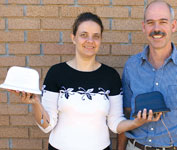Webb develops unique antennas for Transnet
14 May 2008
Telecoms, Datacoms, Wireless, IoT
Webb Industries has supplied Transnet Freight Rail with a series of unique antennas for its locomotives.
These antennas are in response to Transnet's requirement for a wide range of frequencies including VHF, UHF, WiFi, GSM and GPS.
"We have succeeded in housing in one antenna VHF (or UHF), WiFi, GSM and GPS. We believe this to be unique," says Terry Reuss, Webb engineer.
Margherita Perini (left), Webb inventor and Terry Reuss, Webb engineer, show off two of the unique antennas developed specifically for Transnet Freight Rail
Transnet have for some years had dual antennas (GSM and GPS) on their Richards Bay coal line and when WiFi had to be introduced, a new solution was required. "The solution was, in essence, a radical new design consisting of two antennas, one with VHF, WiFi, GSM and GPS and the other with UHF, WiFi, GSM and GPS," says Reuss.
He adds that one of the key challenges of the project was to maintain the same shape and footprint as the older antennas to obviate fitment problems on the locomotives. "In addition to keeping the basic footprint the same, we also made modifications to the outer cover, enabling the antennas to withstand up to 90 kV a.c. voltage without breaking down. We have completed a series of very successful tests on these covers," says Reuss.
Paul Richards, Webb CEO says that he is proud that his company managed to fulfil this brief. "This is the type of ingenuity that has helped us develop a reputation for developing cutting-edge technology in the telecommunications industry."
Transnet Freight Rail's Derrick Marais was equally pleased with the job. "We needed a unique solution and the Webb team came up with it without too much fuss and, of course, within the required budgetary constraints," he said.
He added that these antennas are part of an ambitious programme, Project Triton, to upgrade Transnet's wireless communications with its trains. "The digital age enables us to convey a host of important information to various points, including the locomotive operator and the various control centres. This information includes details of the condition of the locomotives and the wagons being hauled, alarm warnings and other crucial operational information. This entails the transmission of both voice and data, hence the requirement for so many frequencies. We needed to reduce the number of antennas as a result, and Webb was able to do this."
For more information contact Webb Industries, +27 (0)11 444 2299, [email protected], www.webb.co.za
Further reading:
What does Wi-Fi 7 mean for South African networks?
Telecoms, Datacoms, Wireless, IoT
With Wi-Fi 7 (802.11be), we are finally looking at a standard that was built, not just for more devices, but for the new way networks are used.
Read more...
Multiprotocol wireless SoC
RF Design
Telecoms, Datacoms, Wireless, IoT
The nRF54LM20A from Nordic Semiconductor is a multiprotocol wireless System-on-Chip designed for demanding designs in Bluetooth devices.
Read more...
High performance communication
iCorp Technologies
Telecoms, Datacoms, Wireless, IoT
Quectel’s FCS950R is a high-performance Wi-Fi 5 and Bluetooth 4.2 module that can deliver a maximum data rate up to 433,3 Mbps in 802.11ac mode.
Read more...
Expanded STM32WL3x line for IoT sensors
Altron Arrow
Telecoms, Datacoms, Wireless, IoT
The STM32WL31x and STM32WL30x are more tailored versions of the STM32WL33x for designers who wish to focus on specific features, while lowering their bill of materials.
Read more...
Full-band GNSS helical antenna
RF Design
Telecoms, Datacoms, Wireless, IoT
A key feature of Calian’s HC3990XF antenna design is that it does not require a ground plane, making it ideal for size-constrained applications.
Read more...
BLE and BT Mesh module
iCorp Technologies
Telecoms, Datacoms, Wireless, IoT
The HM-BT4531 from HOPERF is a BLE data transmission module that features an ARM Cortex-M0 32-bit processor.
Read more...
Espressif entering the Wi-Fi 6E market
iCorp Technologies
Telecoms, Datacoms, Wireless, IoT
Espressif Systems is entering the Wi-Fi 6E market, extending its connectivity portfolio into the domain of high-throughput, low-latency wireless solutions.
Read more...
Ultra-low jitter clock buffers
Altron Arrow
Telecoms, Datacoms, Wireless, IoT
New SKY53510/80/40 family of clock fanout buffers from Skyworks are purpose-built for data centres, wireless networks, and PCIe Gen 7 applications.
Read more...
Cutting-edge broadband power amplifier
RFiber Solutions
Telecoms, Datacoms, Wireless, IoT
Designed for high efficiency and reliability, the WPGM0206012M from WAVEPIA is a cutting-edge broadband GaN MMIC power amplifier operating from 500 MHz to 8,5 GHz.
Read more...
The trends driving uptake of IoT Platform as a Service
Trinity IoT
Editor's Choice Telecoms, Datacoms, Wireless, IoT
IoT platforms, delivered as a service, are the key that will enable enterprises to leverage a number of growing trends within the IT space, and access a range of benefits that will help them grow their businesses.
Read more...


